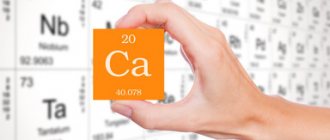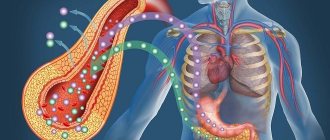Norms and limits of values
To know when magnesium in the blood is high, you need to determine the range of normal values. The concentration of the element in the blood plasma is measured in millimoles per liter (mmol/l), and depending on age, the following limits of its reference values exist:
| Age | Blood level, mmol/l |
| up to 5 months | 0,62-0,91 |
| up to 6 years | 0,7 – 0,95 |
| from 6 to 12 years old | 0,7 – 0,86 |
| adolescence and youth, 12 - 20 years | 0.7-0.91 (reserve during skeletal growth) |
When the skeleton has stopped forming and growing, at the age of over 20 years and into old age, magnesium in the blood ranges from 0.66 to 1.07 millimoles per liter.
When it comes to adults, hypermagnesemia is a condition when the concentration of the element in the blood plasma exceeds 1.07 ml per liter.
What are the reasons? When magnesium in the blood is elevated, what does it mean?
Level up
It should be noted that achieving a significant increase in this element is quite difficult.
Magnesium in the blood is increased when:
- its excessive intake, for example, with antacids or laxatives;
- disturbance of magnesium metabolism;
- renal failure.
Clinical manifestations of hypermagnesemia may include:
- drowsiness, lethargy;
- development of arthritis;
- decreased performance;
- loose stool.
main sources
The table shows data on where magnesium is found in foods the most.
| Name | Magnesium content, mg per 100g |
| Wheat bran | 550 |
| Pumpkin seeds | 500 |
| Cocoa powder | 430 |
| Sesame | 350 |
| Cashew | 270 |
| Buckwheat | 258 |
| Soybeans | 248 |
Below is a table of magnesium in foods.
Foods rich in magnesium also include
bananas, avocados, figs, wheat germ, green leafy vegetables
, sea fish, almonds, chocolate, whole grain bread, dairy products, beans, and potatoes. A natural source of this mineral can be hard drinking water.
As you can see, there is a wide choice. Which magnesium-rich product to choose depends on your taste.
In addition to magnesium, foods fortified with iodine and selenium will help strengthen the immune system.
Table of foods containing large quantities of iodine.
| Name | Iodine content, mg per 100g |
| Sea kale | 1000 |
| Pollock | 150 |
| Cod | 135 |
| Shrimps | 110 |
List of foods containing the most selenium:
- Kelp;
- Seafood;
- Oatmeal, buckwheat;
- Bran;
- Sunflower seeds;
- Onions, tomatoes, broccoli.
Contains a lot of selenium
- Beans;
- Vegetable oil;
- Garlic;
- Brewer's yeast.
A diet with reasonable consumption of foods rich in carbohydrates will help you avoid excess weight.
Diseases associated with insufficient magnesium are very common. These include hernias, myopia, and curvature of the spine. Also, a lack of microelement is fraught with frequent dislocations, and in more serious cases – problems with the blood vessels of the heart.
These health problems are a consequence of weak connective tissue. The defect occurs when the body does not receive enough magnesium. The microelement is the main “food” of connective fibers, helping them remain elastic and correctly positioned.
Men and women have different needs for magnesium. The first daily intake is about 400 mg before the age of 30 and 420 mg after. Women under 30 years of age need 310 mg of magnesium and 320 mg thereafter. You can compensate for the lack of an element with the help of dietary supplements or by slightly changing your diet.
What foods contain magnesium?
We take Mg with food and drinking water, however, only with hard water, where it is in abundance. Here are some foods containing magnesium:
- bread (coarsely ground),
- nuts,
- buckwheat grain,
- beans,
- bran,
- oatmeal,
- If we talk about which products contain a lot of magnesium, then this is, of course, cocoa - 440 mg per hundred grams of product.
- Magnesium is found in fresh foods that have not been processed.
When cooking vegetables, Mg is removed, and a large amount of it is also consumed when they are peeled, since it is usually located under the skin. If you are looking for what contains magnesium in winter, then dried fruits, especially apricots, raisins, and dates, may be an additional resource.
But even if you eat normally and nutritiously, you may not have enough Mg. Those who do not eat a sufficiently complete and varied diet, or who have noticeable disruptions in the absorption of the element (for example, with thyroid disease), exhibit a deficiency of this mineral.
What is magnesium in human blood
Magnesium, along with sodium, calcium and potassium, is an electrolyte.
It is an ion that can be positively or negatively charged. All these elements perform certain tasks and functions to ensure that the human body works at the proper level.
For the first time in history, Gemri Devi, a chemist from England, managed to isolate magnesium. This discovery occurred in 1808. Scientists have now established that the earth's crust contains only 2% magnesium.
Magnesium ranks fourth in the ranking of element concentrations in the human body. It is second only to calcium, sodium, and potassium. But it is in second place after potassium in the ranking of the content of elements in individual cells. In total, there will be about 25 g of this substance in the entire human body. Moreover, more than half of the total volume of magnesium belongs to bone structures. Everything else goes to other cells. And only 1% of magnesium is found in human extracellular fluids. Almost 75% of the total volume of magnesium is in ionizing form. 2% is bound to globulin, and 22% of magnesium is bound to albumin.
The largest percentage of this trace element is found in the myocardium. Magnesium and calcium are antagonists, so if the concentration of magnesium decreases, the amount of calcium increases. The more active a cell is, the more magnesium it requires. This element is a cofactor for many enzymatic processes in the human body. It affects the level of pyrimidine and purine bases and is a regulator of growth processes. This substance is necessary at all levels of protein production in the human body.
Determining the level of magnesium in the blood is a fairly rare procedure. To do this, blood is given for analysis. It is necessary to find out the quantitative indicator of magnesium in the blood fluid if renal failure is suspected.
In addition, when a person has neurological pathologies, this test must be taken. For example, determination of magnesium in the blood is required for tremors, muscle hypotension, convulsions and hyperexcitability. In addition, if you have adrenal insufficiency, you need to undergo similar tests. The same applies to people who suffer from renal arrhythmia.
Signs of disease development
Many people believe that if there is an excess of microelements in the body, then this is good, the main thing is that there is no deficiency. The opinion is wrong. With a sudden increase in Mg in the blood, a person’s condition worsens significantly. If the level of the element is more than 7 mmol/l, cardiac arrest is possible.
Symptoms of hypermagnesemia:
- weakness throughout the body, loss of balance, impaired consciousness, drowsiness, possible paralysis;
- disturbances in the functioning of the digestive tract - nausea, vomiting, intestinal upset;
- vasodilation, which leads to breathing difficulties.
Such changes in the body occur due to inhibition of neuromuscular transmission, suppression of the excitability of the nervous system, which is provoked by an increase in the level of magnesium and potassium in the intercellular fluid.
Analysis for magnesium: the essence of the method
Micronutrient levels can be determined in many ways
There are various methods for determining the level of Mg in the blood: flame photometry, spectrographic, fluorimetric and others. The most widely used colorimetric method is based on the ability of magnesium ions to form compounds with dyes in the presence of alkali. Titanium yellow, which forms a bright red color with Mg, as well as mahogany, which forms a wine-red complex with Mg, are usually used as dyes. The optical density of the stain is directly proportional to the amount of magnesium in the blood sample. The color intensity is measured using a colorimeter, then a calibration graph is built based on the indicators of the control and test samples.
Symptoms of low and high amounts
Long-term deficiency of the mineral – hypomagnesemia – leads to pathological changes in the body. Magnesium deficiency is most often observed in children, pregnant women and people engaged in heavy physical labor, as well as athletes.
Any imbalance of microelements in the body causes a malfunction in its functioning. An increased level of magnesium in the blood, as well as a low level, negatively affects a person. Excess of the mineral - hypermagnesemia - occurs if the concentration of Mg in the blood is more than 2 mmol/l.
Symptoms indicating excess or deficiency are almost the same:
- increased heart rate, changes in blood pressure;
- the appearance of black spots before the eyes, dizziness, frequent migraines;
- muscle cramps and spasms;
- pain in the heart, stomach, abdomen;
- deterioration of nails, teeth, hair loss.
A low level of the mineral in the body is indicated by frequent irritability, weakness, a constant feeling of fatigue, sleep disturbance, deterioration of memory and attention.
If there is increased magnesium in the blood, blood pressure decreases, pulse and heart contractions slow down, and loss of consciousness is possible.
Symptoms indicating a lack of magnesium or its excess in the blood in children are the same as in adults. Parents should be wary if:
- the child has become worse at school, has problems remembering the material he has learned, and has difficulty completing his homework;
- behavior has changed dramatically, for example, the child has become whiny, irritable, often quarrels with friends, is rude to parents, refuses favorite activities, shows apathy, or has a sudden change in mood;
- the child has trouble falling asleep, sleeps restlessly, and often has nightmares.
With a high concentration of the mineral, the manifestations are the same as when the norm in children is not achieved.
The importance of normalizing magnesium levels and the consequences of imbalance
This element is necessary in the formation of muscle and bone tissue, energy production, antibodies and glucose absorption. The mineral prevents the formation of blood clots, thins it, and strengthens the walls of blood vessels.
When there is a lack of it in the body, symptoms of chronic fatigue arise:
- malaise, apathy;
- emotional instability, anxiety, irritability, tearfulness;
- headache, sleep disturbance.
Deficiency disrupts blood supply, thickens the blood, which causes a malfunction of the heart muscle.
The deficiency is especially dangerous in women during pregnancy, as it provokes:
- placental abruption;
- toxicosis and gestosis;
- polyhydramnios;
- delayed fetal development.
Deficiency of the mineral has a negative impact on women during menopause, when the body, making up for the deficiency, takes it from bone and muscle tissue.
In children with low magnesium levels, the emotional background is disturbed, calcium is less absorbed, which negatively affects bone formation.
An excess of the element causes the development of diabetes mellitus, muscle or respiratory paralysis, and in expectant mothers it provokes spontaneous abortion.
What are our needs for this microelement?
This substance directly affects the body’s production of antibodies, so without it we are unable to properly resist viruses and infections. In addition, the connection of magnesium with a number of other microelements, for example, potassium, sodium, calcium, phosphorus, has long been proven.
With the help of magnesium, calcium is better absorbed in the body. However, an excess of the latter leads to a deficiency of the former.
To date, there is no consensus among experts regarding the necessary daily requirement for this substance. Most people take the position that a dose of 300-500 mg of this element is needed per day.
In fact, if the digestive system is functioning fully, then magnesium deficiency itself will not appear out of nowhere. Its occurrence is often associated with hereditary diseases, a monotonous unhealthy diet, alcohol addiction, and a lack of fresh fruits and vegetables in the diet.
The normal level of magnesium in the blood of women
The level of magnesium in the blood of women does not differ from that of men, but the consequences of its deficiency can be disastrous. The fact is that thanks to magnesium, the menstrual cycle is regulated, which affects a woman’s ability to conceive.
A lack of magnesium in the body leads to the early appearance of wrinkles, emotional lability and more severe PMS.
The norm of magnesium in the blood of men is also 0.7-1.2 mmol/l, but the daily requirement for this element in men is slightly higher - up to 400 mg. However, much depends on the nature and intensity of the work.
In a female body, in normal health and without problems with absorption, it should contain from 0.8 to 1.3 mmol/l magnesium. Only these limits of indicators can indicate the normal functioning of the heart, nervous system and muscle tissue.
Sometimes a sharp decrease in magnesium can be associated not only with the development of dangerous pathologies, but also due to poisoning, when a woman has diarrhea, due to the use of diuretics for weight loss or treatment of genitourinary infections, as well as under the influence of a low-carbohydrate diet. Despite the fact that these factors are temporary, if there is no treatment to eliminate them, the decline in magnesium may continue.
This occurs due to the excess concentration of magnesium in the solution, which is used to restore the mineral balance in the body.
Female representatives need this macronutrient much more than men. Magnesium helps normalize hormonal levels, which, in turn, ensures a regular menstrual cycle
This is important for the onset of ovulation and conception of a child.
The lack of this component affects not only the condition of the expectant mother, but also the intrauterine development of the baby. To prevent this from happening, doctors quite often prescribe magnesium preparations to patients: Magne-B₆ or Magnicum. The dosage is prescribed only by the attending physician, based on the results of a blood test for magnesium.
To prevent this macroelement from being excreted from a woman’s body in large quantities, you should not abuse diuretics or teas. If, due to certain circumstances, you have a need to use them, then take care of regularly replenishing the magnesium supply in the blood, having consulted with your doctor first.
When is it appointed?
A blood test for magnesium is prescribed for some neurological pathologies. The following situations may also be indications:
Increased potassium in the blood
- muscle weakness, cramps, tremors;
- tingling in the fingertips, numbness;
- increased excitability;
- anxiety, depression;
- heart rhythm disturbance;
- insomnia, apathy, hallucinations;
- memory loss, confusion;
- dizziness, frequent migraines;
- nausea, vomiting, intestinal dysfunction;
- shortness of breath, asthma attacks.
Such a study is prescribed for patients with diabetes mellitus, renal failure, Addison's disease to determine the severity of pathologies and the effectiveness of treatment. It is needed to assess the functioning of the thyroid gland, adrenal glands, and in the treatment of calcium-phosphorus metabolism disorders. It is necessary to conduct such an analysis in case of calcium or vitamin D deficiency, osteoporosis and other joint pathologies. It is definitely prescribed to women during pregnancy.
A blood test for magnesium is prescribed by a doctor for many pathologies.
Note! This test can be taken free of charge only if there are signs of a serious deficiency or in case of severe pathologies. In Moscow, determining this indicator will cost 150-210 rubles.
How to prepare for analysis
To accurately determine whether magnesium in your blood is normal, you need to stop eating. The test is performed only on an empty stomach in the morning. In addition, 1-3 days before the procedure, you need to stop drinking alcohol. The same applies to smoking, of course, if possible. The day before the blood is drawn, the patient should refuse any physical activity, as well as lifting heavy objects.
A week before the procedure, you need to exclude from your diet all foods that have food additives. Especially those containing large amounts of magnesium. The same applies to medications that contain magnesium.
The material for analysis is blood serum, but hemolysis must be avoided. The test is carried out over one day.
What analysis determines
To determine the content of magnesium in blood plasma, use. The material for analysis is venous blood. In order for the test results to be most reliable, it is necessary to follow some rules when preparing for analysis:
- There should be a time interval of at least 8 hours between blood sampling and the last meal;
- several hours before donating blood, it is necessary to exclude any physical and emotional stress;
- stop smoking 40-60 minutes before donating blood;
- Avoid taking magnesium and calcium supplements no later than 4-5 days before the expected blood donation.
Magnesium is a vital trace element, an alkaline earth metal, without which the main stages of metabolism cannot occur. Denoted by the symbol Mg
, Latin name Magnesium. The element was discovered in 1755.
Metabolism (or metabolism) is the basis of the life of any living organism; it is a cascade of chemical reactions that provide the body with the necessary substances, as well as a sufficient amount of energy. Vitamins, microelements, enzymes and many other compounds are involved in metabolism. Magnesium is involved in many biochemical reactions and is one of the most important components in the regulation of most physiological processes.
Without magnesium, it is impossible to activate at least three hundred enzymes, as well as B vitamins. Magnesium takes part in all types of metabolism: carbohydrate, lipid and protein. This trace element is necessary to maintain electrolyte balance.
Magnesium plays a special role in the functioning of nervous and muscle tissues, which have spontaneous electrical activity and conductivity: magnesium in this case regulates the permeability of cell membranes to other ions and the adequate functioning of the potassium/sodium pump in them. Magnesium plays an important role in the immunological processes of the body.
Magnesium is involved in thermoregulation of the body, the metabolism of calcium, sodium, ascorbic acid, phosphorus, in the synthesis of phospholipids, has a vasodilating effect and prevents red blood cell aggregation. In the body, magnesium is active in the form of divalent Mg ions, since only in this form can it form compounds with organic substances and perform its functions in biochemical processes.
Reasons for reducing the amount of magnesium in the blood
Considering that magnesium is a fairly common element in nature, yet approximately half of the people on the planet are diagnosed with its deficiency. Moreover, the symptoms of this disease appear very rarely.
When there is a deficiency of the substance, a person experiences anxiety and constant stress, while this condition cannot be explained by other reasons, including those of a psychological nature. A person may experience irregularities in heart rhythm. Sometimes I get cramps. Most often this occurs at night.
The calf muscle is mainly affected. In some cases, cramps do not appear, but muscle twitching is still present. There is tingling and numbness in the fingers. The patient may have insomnia. Depression begins to develop, and an apathetic state appears. You may have a constant headache and migraine attacks. The patient complains of fatigue, lethargy and weakness.
Overdose
An overdose of magnesium can occur with incorrect dosing of magnesium preparations, mainly with intravenous administration. You should not be afraid of excess intake from food
, since the daily diet contains mainly refined foods that are poor in magnesium. Part of the microelement is lost during heat treatment and preservation. Therefore, it is recommended to consume vegetables and fruits raw whenever possible. Residents of areas with soft drinking water do not receive enough magnesium.
As mentioned earlier, sources of magnesium for the body are: food, water (hard), salt. Products rich in magnesium salts include: cereals (buckwheat and millet), legumes (peas, beans), watermelon, spinach, lettuce, milk, tahini halva, nuts. Some types of bread are rich in this microelement - rye, and to a lesser extent wheat.
Dark chocolate is beneficial not only for its well-known antioxidant and tonic properties, but also for its high magnesium content. The magnesium content in meat products is not as high as compared to cereals. Very little of it is found in apples and plums. Dried fruits are rich in various elements, including magnesium, especially dried apricots, figs, and bananas. The leader in magnesium content is sesame.
If necessary, magnesium preparations are prescribed for preventive or therapeutic purposes, which are available in pharmacies without a doctor’s prescription. However, it is not recommended to start taking medications on your own without first consulting a specialist. Only he can reliably determine whether there is a need to take these drugs, and will select the correct dosage regimen and dosage, taking into account age, physical activity and gender. Nutritional correction is often sufficient.
Causes of hypermagnesemia
It should be said right away that hypomagnesemia, or low content of the element, is much more common. Perhaps, clinical conditions and situations associated with it can be counted twice as many as when elevated magnesium occurs in the blood.
The most common clinical conditions and diseases are:
- Overdose of antacid substances in patients with hyperacid gastritis to relieve heartburn. Many drugs, for example Phosphalugel, Almagel and others contain magnesium compounds, which have an enveloping effect and alleviate and eliminate the symptoms of heartburn. Therefore, if the patient uses them very often, and especially against the background of a chronic decrease in kidney function, excess magnesium in the blood may occur;
- The most common cause of elevated magnesium in the blood is chronic renal failure in general, and this must be remembered when bringing a patient with chronic renal failure;
- A state of hyperfunction of the parathyroid or parathyroid glands, when magnesium is actively washed out of the bone tissue and enters the blood. This uncontrolled influence of parathyroid hormones occurs in the event of a lack of the antagonist hormone, calcitonin, which is produced by the thyroid gland. Therefore, excess magnesium in the blood plasma can be considered an important biochemical sign of hypothyroidism, or myxedema;
- Excess magnesium occurs in bronze or Addison's disease, as well as in the case of diabetic ketoacidosis in patients with severe type 1 diabetes;
- Conditions in which hypermagnesemia develops are blood thickening, or dehydration due to diarrhea, and excessive sweating. But they can be ignored, since massive, polyionic disorders occur, and not just isolated hypermagnesemia.
Are there any symptoms of hypermagnesemia? How does excess magnesium in blood plasma manifest itself? How does it affect your well-being?
Sources of magnesium
There are a large number of sources of this element in nature. These include products of plant and animal origin. You can also get a lot of this substance in the earth's crust. Sea water contains a certain amount of magnesium. Even cobblestones have this substance. For example, a kilogram of stones, which are usually used for laying roads, contains about 20 g of magnesium. By the way, it can be extracted, but this process will be very expensive and time-consuming.
Magnesium is found in vegetables and grains. Its high content is observed in legumes. Spinach, cocoa, nuts, seeds, and onions also contain a lot of magnesium. It is precisely because of the large amount of magnesium that wheat and oats are useful. But during heat treatments, the beneficial properties and elements in these products are completely lost or their content is partially reduced. If you use chemical fertilizers, the plant will not absorb magnesium well.
Everyone knows, from childhood, that for health and energy it is necessary to receive adequate nutrition. A person must receive useful elements that ensure the uninterrupted functionality of all systems and organs. How does consuming Mg benefit us?
Mg is considered one of the most common elements, an essential part of dentin and bones in humans, animals and plants. Ions of the element are included in the water we drink, and Mg chloride is found in sea waters.
Reasons for increasing the concentration of magnesium in the blood
If there is an excess of Mg ions in the body, this indicates that there is a violation in the functioning of the kidneys, that is, they do not sufficiently remove it from the body. In addition, there are other factors in the development of pathology.
The main causes of hypermagnesemia:
- excessive saturation of the body with magnesium (abuse of drugs containing Mg, use of serums with a high concentration of microelement ions during pregnancy);
- renal failure;
- a disturbance in the acid-base balance, which provokes the redistribution of Mg from cells into the intercellular fluid.
The general picture of hypermagnesemia can be seen in the photo below.
Relationship with other macronutrients
Magnesium regulates the absorption and exchange of other chemical elements in the body. With its deficiency, sodium and phosphorus stop participating in the transmission of nerve impulses, calcium and vitamin D are poorly absorbed into the bone structure.
The mineral reduces the negative effects of heavy metals by 30% and reduces the risk of intoxication. The macroelement is a natural calcium antagonist, so their ratio in tissues should be 1:2. The chemical element prevents calcium from entering the body uncontrollably with food. If the body becomes deficient in the mineral, calcium will begin to accumulate in the form of stones in the kidneys, gall bladder and bladder.
With the introduction of magnesium, the flow of potassium into the cells increases. If the latter begins to be released into the intercellular space, sodium takes its place. Thanks to the joint work of chemical elements, cell organelles function normally.
How to recognize and compensate for magnesium deficiency in the body
Every organ in our body, especially the muscles and heart, needs magnesium to function properly. Magnesium is involved in more than 300 biochemical processes. This is quite a difficult task, so you definitely want to make sure you're getting the magnesium you need. But in fact, there is a fairly high risk that your body is deficient in this valuable element.
A third of the inhabitants of our country suffer from a lack of magnesium in the body. Up to 75 percent of Americans do not meet the minimum daily requirement for this mineral, which ranges from 310 to 320 mg for women and 400 to 420 mg for men. Since only 1% of the body's magnesium is found in the bloodstream, a blood test is not a good way to determine whether you are deficient.
Doctors also indicate that consuming large amounts of animal proteins and fats interferes with the absorption of magnesium ions.
Other causes of magnesium deficiency in the body may include older age (the ability to absorb this element decreases with age), the use of certain medications (for example, diuretics, antacids, insulin, corticosteroids, some antibiotics), and gastrointestinal disorders such as Crohn's disease or leaky intestines. Stress, physical and emotional stress also remove magnesium from our body.
The role and functions of magnesium
Not every person knows what magnesium is and what its importance is for the body. It is present in muscles, bones, endocrine glands, and blood.
This is an important element necessary for the normal functioning of many systems. It relieves neuromuscular tension, participates in protein synthesis and the absorption of vitamins, especially B6, for which the presence of this mineral is necessary.
- relaxing the heart muscle and preventing an attack;
- reducing the risk of strokes;
- normalization of sleep;
- optimization of the gastrointestinal tract due to normal muscle contraction and relaxation;
- preventing the accumulation of excess fluid in tissues.
In addition, its imbalance can provoke the development of connective tissue diseases and oncological processes.
Normal microelement content has a positive effect on pregnancy, preventing its spontaneous termination, as well as premature birth.
Estradiol
It is produced in the ovaries in women, the testes in men, and estradiol is also produced in small quantities by the adrenal cortex in men and women.
Estradiol
in women, ensures the formation of the reproductive system according to the female type, the development of female secondary sexual characteristics, the formation and regulation of menstrual function, the development of the egg, the growth and development of the uterus during pregnancy; is responsible for the psychophysiological characteristics of sexual behavior. Ensures the formation of subcutaneous fat tissue according to the female type.
It also has an anabolic effect, enhances metabolism in bone tissue and accelerates the maturation of skeletal bones. Promotes sodium and water retention in the body. Reduces cholesterol levels and increases blood clotting activity.
In women of childbearing age, the level of estradiol in blood serum and plasma depends on the phase of the menstrual cycle. From the beginning of the menstrual cycle, the content of estradiol
in the blood gradually increases, reaching a peak towards the end of the follicular phase (it stimulates the release of luteinizing hormone before ovulation), then in the luteal phase the level of estradiol decreases slightly. During pregnancy, the content of estradiol in serum and plasma increases at the time of birth, and after birth it returns to normal on the 4th day. With age, women experience a decrease in estradiol concentrations. During postmenopause, the concentration of estradiol decreases to the level observed in men.
Indications for the purpose of analysis:
- puberty disorder,
- diagnosis of menstrual irregularities and the possibility of having children in adult women (in combination with the determination of other female hormones),
- scanty menstruation (oligomenorrhea) or absence of menstruation (amenorrhea),
- lack of ovulation,
- infertility,
- premenstrual syndrome,
- discirculatory uterine bleeding (disturbing the cycle),
- hypogonadism (underdevelopment of the genital organs),
- osteoporosis (thinning of bone tissue in women),
- increased hair growth (hirsutism),
- assessment of the functioning of the fetoplacental complex in early pregnancy,
- signs of feminization in men.
On the eve of the study, it is imperative to exclude physical activity (sports training) and smoking. In women of reproductive age (from approximately 12-13 years of age and before the onset of menopause), the analysis is performed on days 4-7 of the menstrual cycle, unless other dates are indicated by the attending physician.
Normal estradiol levels:
- children under 11 years old
- men 10 – 36 pg/ml,
- women: reproductive age 13-191 pg/ml, during menopause 11-95 pg/ml.
An increase in estradiol levels occurs when:
- hyperestrogenism (increased estrogen levels),
- endometrioid ovarian cysts,
- hormone-secreting ovarian tumor,
- estrogen-secreting testicular tumor in men,
- liver cirrhosis,
- taking anabolic steroids, estrogens (oral contraceptives).
A decrease in estradiol levels occurs when:
- hyperprolactinemia (increased levels of prolactin),
- hypogonadism (underdevelopment of the genital organs),
- insufficiency of the luteal phase of the cycle,
- threat of miscarriage due to endocrine problems,
- intense physical activity in untrained women,
- significant weight loss,
- high-carbohydrate, low-fat diet
- vegetarian diet,
- pregnancy, when a woman continues to smoke,
- chronic prostatitis in men,
- some specific diseases.
See: Tests Important for Determining Cholesterol Levels
See also:











